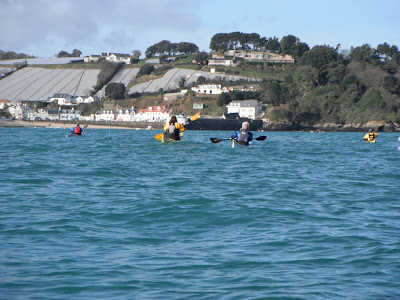The Last Invasion of the British Isles?
As regular readers will know my favourite sea kayaking trip is to the Ecrehous, a delightful reef to the north east of Jersey. Last weekend we were fortunate enough to visit the islands on the large spring tide and had access to one of the huts for the evening. Reading through an old visitors book there was a recording of the events which unfolded during what is possibly the "last invasion of the British Isles".
In 1993 a group of French fishermen landed on the reef and pulled down the Union Flag, which flies when people are in residence on the reef. It flies over the southern end of La Marmotiere.
 Information was received that in 1994 a large "invasion" was planned but this time the Jersey police were ready to protect the sovereignty of the reef. The events of the day are recorded in the visitors book by the Police officers who were on the reef.
Information was received that in 1994 a large "invasion" was planned but this time the Jersey police were ready to protect the sovereignty of the reef. The events of the day are recorded in the visitors book by the Police officers who were on the reef.

The log records the following activity during the day
:
9th July 1994
Pc 188 (.......... ..........)
Psgt 161 (....... ............)
Police HQ, 24, States of Jersey Police Officers and St Martins Honorary Police landed at 06.00 in response to threat from French fishermen of a mass planned demonstration by extension of Jersey territorial waters. 09.30 hrs first boat with demonstrators arrived. 10.30 hrs 6 large fishing boats arrived with 100 demonstrators including 12 right wing activists. 11.30 mass with French Priest held on the stone beach, demonstration urged to take action to lay claim to Les Ecrehous. 13.00 fight between two fishermen at the official flag pole was dealt with by Police. Reinforcements - further 12 officers shipped in. A very welcome sight - a calming influence to see the Duchess and two rigid raiders. All demonstrators left on good terms with the community and Police Scene Commander Supt Jones ordered stand down at 19.00. Two officers left on the island overnight.
 The Priest and some of the crowds on the shingle bank. (Apologies I have been unable to discover the photographer)
The Priest and some of the crowds on the shingle bank. (Apologies I have been unable to discover the photographer) The Ecrehous as they should be seen, peaceful with clear waters and interesting tidal flows.
The Ecrehous as they should be seen, peaceful with clear waters and interesting tidal flows.
It is easy to see why some French would want to take over the sovereignty of the Ecrehous but the International Court of Justice ruled in favour of Jersey on the 17th November 1953. It would be interesting to find out if there has been a more recent "invasion" of the British Isles.
















































